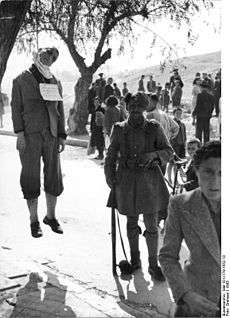Security Battalions
| Security Battalions Τάγματα Ασφαλείας | |
|---|---|
| Participant in the Axis occupation of Greece | |
|
Men of the Security Battalions resting during an anti-partisan sweep in 1943. They are wearing the service uniform of the pre-war Evzones regiments. | |
| Active | 1943–1944 |
| Ideology |
Anti-communism, Fascism, Germanophilia |
| Leaders |
Ioannis Rallis Ioannis Plytzanopoulos |
| Headquarters | Athens |
| Strength | 22,000 (1944) |
| Part of | Hellenic State (1941–44) |
| Allies | Wehrmacht, SS, SiPo, National Union of Greece, Hellenic Gendarmerie, Organization X, Poulos Verband |
| Opponents | EAM/ELAS, KKE, EDES, EKKA, PEAN, EOK, Greek government-in-exile, Special Operations Executive |
The Security Battalions (Greek: Τάγματα Ασφαλείας, Tágmata Asfalías, derisively known as Germanotsoliades or Tagmatasfalites) were Greek collaborationist military groups, formed during the Axis occupation of Greece during World War II in order to support the German occupation troops.
History


The Battalions were founded in 1943 by the Greek puppet government of Ioannis Rallis.[1] They were supported by the extreme right and Nazi sympathisers, but also by some centrist politicians who were concerned about the dominance of ELAS (the military arm of the communist-dominated National Liberation Front EAM) as the main body of the Greek resistance. Among the members of the Security Battalions one could find ex-army officers, forcefully conscripted soldiers, conservatives, landowners, extreme-right radicals and social outcasts, as well as opportunists who believed the Axis would win the war.[2]
The main role of the Security Battalions was to fight against ELAS. Their aggregate force was at most 22,000 men, divided into 9 'evzonic' and 22 'voluntary' battalions, under the commands of SS Lieutenant-General Walter Schimana. Although the plan was to expand them all over the occupied Greek territories, their main theater of action was in eastern Central Greece and Peloponnese. At that time, ELAS had already gained control over 1/3 of continental Greece. They remained faithful to the Germans even when the occupation was crumbling. Their last mission was to engage in combat against ELAS and keep them away from the main routes, in order to secure the safe exit of the German troops from Greece.
What the Greek people hated about the Battalions, even more than their collaborationist nature, was the total lack of control over their members. For example after a battle in the hamlet of Attali in Evvia the collaborationists pillaged the houses of the village, taking away 1,000 oka of oil, five sewing machines, 200 ok of cheese and 30 complete trousseaus. 60 mules were needed to carry away the loot. By the end of the occupation their name was synonymous with arbitrary violence and frightful cruelty.[3]
During the war, the Allied-oriented government in exile decried the Security Battalions for treason. After the liberation, the groups were disbanded; many of their members were tried and were convicted of collaborationism. Their creator, Rallis, was sentenced to life imprisonment for treason. He died in prison in 1946 after months of abuse by his guards.
When the first conflicts of the Greek Civil War broke out in December 1944, however, many of them were recruited into the Gendarmerie to fight alongside the British and government forces against the ELAS guerrillas. The Left has accused the governments of the period of utilizing the Security Battalions against the Communists, while others suggest the Security Battalions joined the anti-communist forces hoping to redeem themselves in the eyes of the public.
Oath of the Security Battalions
According to uncertain references, recruits to the Security battalion were under the following oath:
I swear by God this sacred oath, that I will obey absolutely the orders of the Supreme Commander of the German Army, Adolf Hitler. I will with loyal dedication perform my duties and obey without condition the orders of my superiors. I fully acknowledge that any objection to the obligations hereby accepted will lead to my punishment by the German Military Authorities.
However, it is reported that Rallis, the PM installed by the occupation forces, in the negotiations for the founding of such militia unit on the side of the Nazi occupation forces, refused to accept this oath as "... Greek military forces can't put their legions to a foreign government... ." It is unknown whether Rallis' views were taken into account by German officials.
References
- ↑ Chimbos, Peter D. (1999), "Greek Resistance 1941-45 : Organization, Achievements and Contributions to Allied War Efforts Against the Axis Powers", International Journal of Comparative Sociology, Brill, 40,
Rallis and the Nazis organized the Greek Security Battalions (Tagmata Asfalias) to counter the EAM/ELAS forces (Hondros, 1983:81 ) which were becoming the most powerful and effective resistance organizations.
- ↑ Chimbos, Peter D. (1999), "Greek Resistance 1941-45 : Organization, Achievements and Contributions to Allied War Efforts Against the Axis Powers", International Journal of Comparative Sociology, Brill, 40,
Who were those Greeks who joined the Security Battalions and took an oath to obey the orders of Hitler? They were ex-officers and enlisted men of the Greek army, as well as civilians, with right wing leanings who were sympathetic to the Nazis.
- ↑ Mazower, Inside Hitler's Greece, quoted in Dionysis Charitopoulos, Άρης ο αρχηγός των ατάκτων (=Ares, Leader of the Irregulars) (Athens, Topos, 2009), p. 545 (back-translated by contributor).
Sources
- Mark Mazower (1995). Inside Hitler's Greece: The Experience of Occupation, 1941-44. United States: Yale University Press. ISBN 0-300-08923-6.
- Vasileios Stavrogiannopoulos, Η Ζωή της Κατοχής και τα Τάγματα Ασφαλείας
- Nikolaos D. Christodoulou, Pro-Axis Security Battalions in Southern Greece, 1943-1944
- Antonio J. Munoz, Herakles & the Swastika: Greek Volunteers in the German Army, Police & SS, 1943-1945
- Stratos N. Dordanas (2005). Έλληνες εναντίον Ελλήνων. Greece: Epikentro. ISBN 978-960-6647-31-4.
